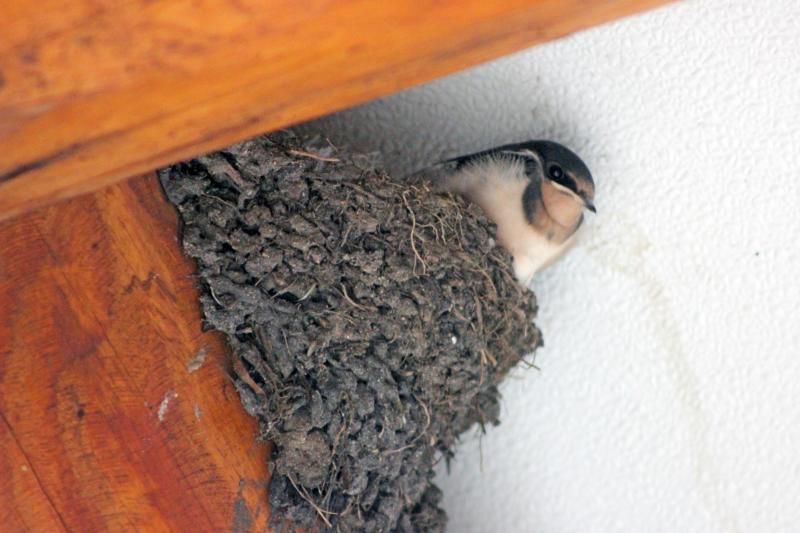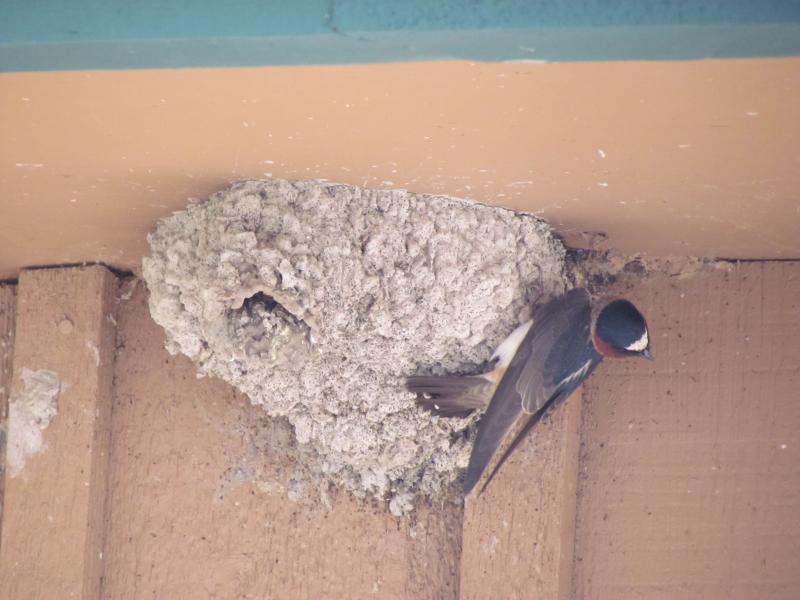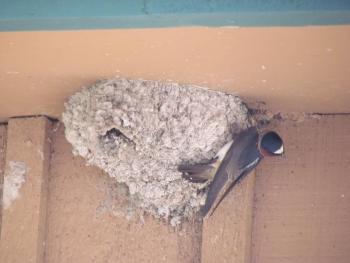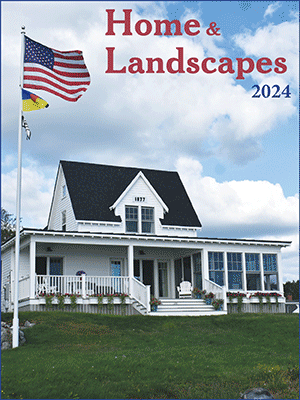Living in an Airport Terminal is for the Birds
 Barn swallows build their nest of mud and grass and often anchor it against a beam within a barn or other building to which they have access. This is a young bird getting ready to leave the nest. Photo by Courtney Celley/USFWS, courtesy of Wikimedia Commons
Barn swallows build their nest of mud and grass and often anchor it against a beam within a barn or other building to which they have access. This is a young bird getting ready to leave the nest. Photo by Courtney Celley/USFWS, courtesy of Wikimedia Commons
 The cliff swallow's gourd-shaped nest, built of mud pellets, was once a common sight under the eaves of homes and barns in midcoast Maine. This photo was taken of a nesting colony in a garage in Yellowstone National Park. Courtesy of Jeff and Allison Wells
The cliff swallow's gourd-shaped nest, built of mud pellets, was once a common sight under the eaves of homes and barns in midcoast Maine. This photo was taken of a nesting colony in a garage in Yellowstone National Park. Courtesy of Jeff and Allison Wells
 Barn swallows build their nest of mud and grass and often anchor it against a beam within a barn or other building to which they have access. This is a young bird getting ready to leave the nest. Photo by Courtney Celley/USFWS, courtesy of Wikimedia Commons
Barn swallows build their nest of mud and grass and often anchor it against a beam within a barn or other building to which they have access. This is a young bird getting ready to leave the nest. Photo by Courtney Celley/USFWS, courtesy of Wikimedia Commons
 The cliff swallow's gourd-shaped nest, built of mud pellets, was once a common sight under the eaves of homes and barns in midcoast Maine. This photo was taken of a nesting colony in a garage in Yellowstone National Park. Courtesy of Jeff and Allison Wells
The cliff swallow's gourd-shaped nest, built of mud pellets, was once a common sight under the eaves of homes and barns in midcoast Maine. This photo was taken of a nesting colony in a garage in Yellowstone National Park. Courtesy of Jeff and Allison Wells
A few days ago, on one of the bitterly cold days we have recently endured, we looked out of the kitchen window to see a bird flit past the window and into the open garage. It was likely a Carolina wren, a bird species well known for curiously probing around homes, garages, and outbuildings, and other things associated with humans. Mom and Dad Childs had one build a nest in the clothespin bag that they had hanging off the clothesline behind their place in Florida.
It got us thinking about how adaptable some bird species can be to new habitats, situations, and food sources. One species that comes quickly to mind is the house sparrow. At some point many thousands of years ago, house sparrows in Eurasia adapted to life with humans. They nested in buildings and picked up grains and scraps around farms and homes. After being introduced to the New York City area from Europe in the 1800s, house sparrows spread across the continent by finding food and shelter in and near human settlements and farms.
There is no doubt they are an adaptable species when it comes to human-made environments.
So it should probably not come as a surprise to find that house sparrows are now one of the most frequently encountered bird species found living INSIDE big box stores and airport terminals in the U.S. and Canada. We’ve certainly seen them living inside many U.S. airport terminals and in a number of big box retail stores right here in Maine and elsewhere. We’ve heard of a few other species making a living inside airport terminals, including northern mockingbird and European starling, but house sparrows seem to be by far the most common and widespread.
When considering other birds that have adapted to incorporate human-made structures into their ecology, one has to think of the barn swallow as another of the early adopters. Originally nesting in caves, thousands of years ago European barn swallows found that the open houses of people were great places to nest. This must have allowed them to greatly expand their range and numbers. Barn swallows in North America apparently followed this same pattern of switching from nesting on cliffs and cave walls to human-made structures. Was this prevalent within certain Native American structures over thousands of years? There is mention of this in one publication in the early 1900s. Or was it mostly adopted as a life history strategy after Europeans arrived in North America and began building their particular style of homes and barns?
Herring gulls are known to have started nesting on large, flat roof tops as early as the 1930s in the UK and in North America in the 1970s. A number of other gull and tern species also now regularly nest on such rooftops all around the world. Portland has its own rooftop nesting herring gulls that have been studied by Noah Perlut at the University of New England. Killdeer also sometimes now nest on large, flat gravel rooftops (they were first documented doing so in 1925). Gardiner Area High School inadvertently hosted a killdeer family that hatched on the rooftop of the gym a few years back. Unfortunately, killdeer chicks need to find their own food after hatching and there’s probably not much on a roof top. Somehow, at least a couple of the killdeer chicks made it off the roof with no apparent injury in this case and seemed to eventually fledge successfully.
Some other birds that associate regularly with human structures include chimney swifts (obvious where they nest!) and eastern phoebes that nest under the eaves of garages and sheds. Cliff swallows used to be common nesters under the eaves of houses and barns all along Maine’s mid-coast area but, sadly, they have almost completely disappeared in recent years.
The bird that flew into our garage and started this musing had vacated it by the time we went out to get a shovel to clean up the front steps from the overnight snow. Later, though, we heard the familiar churring scold of a Carolina wren in the backyard while a flock of house sparrows noisily chipped from the depths of a bush near the garage. Birds and humans, humans and birds, what a long, shared history we have.
Jeffrey V. Wells, Ph.D., is a Fellow of the Cornell Lab of Ornithology and Vice President of Boreal Conservation for National Audubon. Dr. Wells is one of the nation's leading bird experts and conservation biologists. He is a coauthor of the seminal “Birds of Maine” book and author of the “Birder’s Conservation Handbook.” His grandfather, the late John Chase, was a columnist for the Boothbay Register for many years. Allison Childs Wells, formerly of the Cornell Lab of Ornithology, is a senior director at the Natural Resources Council of Maine, a nonprofit membership organization working statewide to protect the nature of Maine. Both are widely published natural history writers and are the authors of the popular books, “Maine’s Favorite Birds” (Tilbury House) and “Birds of Aruba, Bonaire, and Curaçao: A Site and Field Guide,” (Cornell University Press).




































